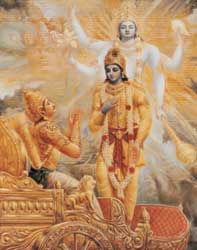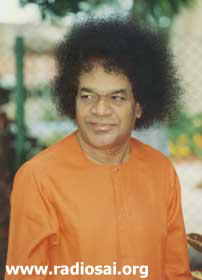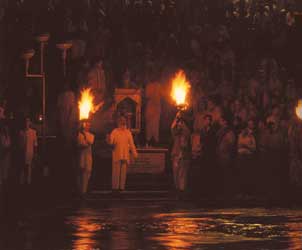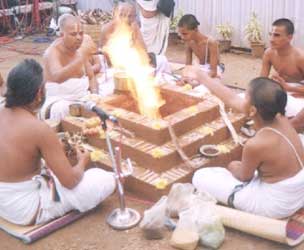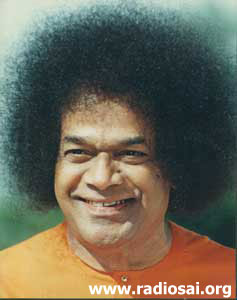 |
 |
 |
 |
| Volume 4 - Issue 09 SEPTEMBER 2006 |
|
|
MUSINGS FROM PRASANTHI NILAYAM UNDERSTANDING AND ATTAINING THE SUPREME BEING - THE VEDIC WAY
Loving Sai Ram and greetings from Prashanti Nilayam. This is my eighth talk in the Veda Walkthrough series. Last time, I dealt with some aspects relating to the end of life, quoting some Mantras, in English translation of course, from Ramundo Panickkar’s monumental book. I shall now move away from Panickkar’s book, and, by way of slowly winding down on this series, I shall now mention a few related points. The Vedas Point the Way to God The first thing I would like to point out is that though individual Vedic rituals might be directed at deities, the grander aspect of Creation and the Creator are not lost sight of. We must understand that the Vedas were meant to cater to a wide spectrum. As the custodian of the Vedas, the Brahmins were expected to preside over various rituals performed by ordinary folk and guide these people by drawing their attention to the practical aspects of Dharma. I shall point out some examples of this shortly. For the moment, however, I wish to highlight the fact that where the Brahmins themselves were concerned, they were expected to focus on the highest aspects of Vedic philosophy. Thus it is that we find in the Vedas many hymns directly in praise of the Supreme One. Here, for example, are some verses from the Rig Veda, where the hymn is based on the rhetorical question: Who is it that we should worship?
That is very poetic, is it not? Hailed as Sarveswara the Supreme Lord, He is extolled in the Svetasvatara Upanishad thus:
In the Mahanarayana Upanishad, which, incidentally, we hear chanted often in Swami’s presence, it is said:
And so on it goes. The Mandukya Upanishad puts it all very crisply thus:
In the Prasna Upanishad, the Supreme Lord is described thus:
And in the Taittriya Upanishad which we have already reviewed, He is described in the same tone:
The Path of the Bhagavad Gita One cannot talk about the Vedas without some reference at least, to the Bhagavad Gita. The Gita can understandably be described in any different ways but for the present, I would choose to describe it as the direct authentication of Vedic Wisdom by God Himself. God in human form not only corroborates all that is said in the Vedas in various places but also goes far beyond, by opening up a simple path by following which anyone can, if he or she so chooses, attain God by observing just a few very simple rules. Basically, the Gita reveals to man how by loving God, man can attain God, without any jeopardy to his normal call of duty. And that the God man so attains, is nothing but the Brahman whom the Vedas extol.
“God has everything. Being the Creator of everything, there is no need for God to desire this or that. God does not incarnate to ask man for service or favours. God incarnates so that man may have God in his radar screen. When God is physically present directly in front of his eyes, man feels an urge to serve God. That is the opportunity that the Avatar presents to man. Some people are not quick on the uptake, and so God asks people sometimes directly and sometimes indirectly, ‘Will you do this for me’.”
In His earlier incarnation as Lord Krishna, our Swami said this, and this is very important:
Even the vilest of sinners shall be counted as righteous, if he turns to me with undivided devotion; for he has chosen the right path. These are incredible pronouncements that only the Lord can make. And just listen to this guarantee.
By the way, these remarkable slokas or hymns are all from the ninth chapter. It is no surprise then that in the post-Krishna period there was a great following for the Lord in the form of Krishna. Indeed, many saints did exactly what was prescribed and attained precisely the destiny promised. In short, I would say, using a modern idiom that the Bhagagavd Gita is nothing short of Vedanta for dummies! I am sure with all these remarks, you would be able to recall innumerable statements from Swami where all these assurances have not only been reiterated but even exceeded; in other words, Swami is giving bargains far exceeding Krishna’s offers! That really is what the Lord’s compassion is all about. Sacrifice – a Vedic Value Changing the gear somewhat, one theme that occurs right across the Vedas is SACRIFICE. The Sanskrit word for sacrifice is Tyaga, and there is a Vedic passage extolling sacrifice that Swami often quotes. In the Vedas, the theme of sacrifice may be seen in two distinct perspectives. One of these is what I would like to call Cosmic External, and the other Sublime Internal. As is to be expected, the two concepts are in fact related. The Outer Sacrifice Let me start with what I refer to as the Cosmic External aspect. The basic idea here is that the human is but one cog in a massive engine called the Cosmos. The Cosmos has innumerable entities ranging from stars and galaxies at one end to insects, plants, animals and so on at the other end. Everything in God’s Creation has a purpose for its existence, and plays a role in the Cosmic Scheme of things, though we might not be aware of it. In this sense, not only the Universe but every single entity in it, big or small, has a definite purpose for its existence. This, of course, goes against the belief common amongst many modern scientists, that the Universe simply happens to exist and has no purpose.
The important point here is the interconnectivity of existence. The point needs to be underscored especially in today’s world, when many hold that man is supreme, that everything exists for his benefit, and he can even do what he wants. Take, for example, the question of bio-diversity. Bio-scientists have recognised that bio-diversity in Nature is good for ecosystems and for mankind too, and must not be disturbed. However, genetic engineering promoted by many companies, it is feared, would greatly harm bio-diversity by making just a few species of plants dominate. This would be clearly going against the structure of Nature but the protagonists of genetically modified seeds could not care less about such considerations. Another example: there are many coral reefs round the world, some of them truly famous. However, their very fame has spelt their doom. Heavily promoted as tourist destinations, many of these reefs are in danger of being wiped out. It was not realised, until recently, that coral reefs play a vital role in preserving balance in marine ecosystems. They are the breeding ground for many marine species, which in turn support many types of fishes. Damage to coral systems has caused, in many places, heavy destruction of many species of fishes. I can cite many examples but shall not at the moment. Maybe in a talk later, I shall deal extensively with ecosystems. Currently, the point I want to make is that man’s superior abilities does not give him any special license to disturb eco-balance in anyway. God has given man superior abilities not for damaging the environment but to become conscious of God and move towards Him. Misuse of Divine capabilities endowed by God to man for a special purpose is a great sin.
Here, sacrifice is commended in order to achieve a balanced co-existence with Nature. The word sacrifice normally makes people say: “I am being asked to simply give up something that I have earned with hard work. Is this not unfair?” Krishna dispels such notions. Maybe the person might think he or she has worked hard, but there can be no gains unless there is the Grace of God. Thus, what people think they are sacrificing is really something that has been given to them by God. They are not giving away some material thing of theirs, but something given to them by God. To make sure that this idea is not forgotten, Krishna says:
Food is one of the great gifts of Nature. We do not realise it but all food comes really from Nature and not the supermarket. Reminding man of this, Krishna says:
These slokas are from the fourth chapter of the Gita, where Krishna really goes to town on the subject of sacrifice. Here are some more slokas from that same chapter:
I am sure you would have noticed that all that I have said so far about sacrifice is actually connected with the so-called external aspect. We receive, and so we must also give; better it is give more than what we receive. One important thing to remember is that what we give or sacrifice is something that would bring material advantage in some form to us if we did not give that away. Thus, the term sacrifice is used in the traditional sense.
Sacrifice means giving up one’s desires, greed and extreme miserliness. Unless you sacrifice desire, anger, greed and so on, you cannot attain Divinity. The Inner Sacrifice That is the real point - Yajnas are performed for achieving Inner Purity through sacrifice, and this is where what I earlier referred to as the Sublime Internal, comes into the picture. However, it must be added that in Vedic times, people did perform Yajnas for propitiating deities and getting boons from them. For example, Emperor Dasaratha performed the famous Putrakameshti Yaga so that he might be blessed with children. This is the external aspect of the Vedic ritual. But the beauty is, as Swami sometimes points out, all these rituals have a sublime internal aspect too. This brings me to my next point which is about fire. In the scriptures, the term fire is sometimes used in a generic sense. Let us get back to the Gita for a moment, and listen some more to Krishna: the few slokas I am now going to quote are from the fifth chapter.
Some perform sacrifice using material objects, some through austerity, others via Yoga, and some again make the study of the scriptures, and the acquisition of knowledge [of the scriptures] their sacrifice – all born of piety.
A Sacrifice of Meat and Alcohol This gives me an opportunity to narrate a small incident and bring this talk to a close. This happened way back in 1995, around October I think, when I paid a three-week visit to New Zealand, on an invitation from the Sai Organisation. The high point was the National Conference, which, it so happened, coincided with the Deepavali festival. The Spiritual Convenor of the New Zealand Sai Organisation had a nice idea. It was to have a fire, and everyone was supposed to write on a piece of paper one or more undesirable habits that the person wanted to get rid of. Everyone was made to stand in a queue, and one by one, people went to the fire, said a small prayer to Swami, and then threw the paper into the fire. The idea was to sacrifice bad habits, with fire as the witness. I thought that this was an excellent way of performing a Yajna in modern times, sticking closely to the basic principle stated by Swami.
So you see, Yajnas are relevant in this day and age too, especially in their Sublime Internal aspect. I hope you will agree with me.
– Heart2Heart Team |
|||||||||||||||||||||||||||||||||||||||||||||||||||||
| You can write to us at : h2h@radiosai.org |
Vol 4 Issue 09 - SEPTEMBER 2006
|
Best viewed in Internet Explorer - 1024 x 768 resolution. |
DHTML Menu by Milonic. |


